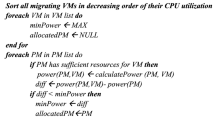Abstract
Cloud computing has emerged as a new powerful service delivery model to cope with resource challenges and to offer on-demand various types of services (e.g., software, storage, network). One of the most popular service models is Software as a Service (SaaS). To allow flexibility and reusability, SaaS can be offered in a composite form, where a set of interacting application and data components cooperate to form a higher-level functional SaaS. However, this approach introduces new challenges to resource management in the cloud, especially finding the optimal placement for SaaS components to have the best possible SaaS performance. SaaS Placement Problem (SPP) refers to this challenge of determining which servers in the cloud’s data center can host which components without violating SaaS constraints. Most existing SPP approaches only addressed homogenous SaaS components placement and only considered one type of constraints (i.e., resource constraint). In addition, none of them has considered the objective of maintaining a good machine performance by minimizing the resource usage for the hosting machines. To allow finding the optimal placement of a composite SaaS, we adopt a new variation of PSO called ’Particle Swarm Optimization with Composite Particle (PSO-CP).’ In the proposed PSO-CP-based approach, each composite particle in the swarm represents a candidate SaaS placement scheme. Composite particles adopt a collective behavior to explore and evaluate the search space (i.e., data center) and adjust their structures by collaborating with other composite or independent particles (i.e., servers). The implementation and experimental results show the feasibility and efficiency of the proposed approach.

















Similar content being viewed by others
Notes
References
Bhardwaj S (2015) Service level agreement aware SaaS placement in cloud. Master’s thesis, National Institute of Technology Rourkela, India, May 2015. Supervised by: Bibhudatta Sahoo
Bowen Y, Shaochun W (2012) An adaptive simulated annealing genetic algorithm for the data placement problem in SaaS. In: Industrial control and electronics engineering (ICICEE), 2012 international conference on. IEEE, pp 1037–1043
Candan KS, Li W-S, Phan T, Zhou M (2011) At the frontiers of information and software as services. In: New Frontiers in information and software as services. Springer, pp 283–300
Cisco (2008) Cisco service-oriented network architecture: support and optimize soa and web 2.0 applications. Technical report, Cisco Inc
Cisco (2015) IDC report, the new need for speed in the datacenter network. Technical report, Cisco Inc. Accessed 24 May 2016
Huang K-C, Shen B-J (2015) Service deployment strategies for efficient execution of composite SaaS applications on cloud platform. J Syst Softw 107:127–141
Kichkaylo T, Ivan A, Karamcheti V (2003) Constrained component deployment in wide-area networks using AI planning techniques. In: Parallel and distributed processing symposium, 2003. Proceedings of the International. IEEE
Kumar A (2014) Placement of software-as-a-service components in cloud computing environment. Master’s thesis, National Institute of Technology Rourkela, India, June 2014. Supervised by: Bibhudatta Sahoo
Kwok T, Mohindra A (2008) Resource calculations with constraints, and placement of tenants and instances for multi-tenant saas applications. In: Service-oriented computing—ICSOC 2008. Springer, pp 633–648
Liu L, Yang S, Wang D (2010) Particle swarm optimization with composite particles in dynamic environments. IEEE Trans Syst Man Cybern B Cybern 40(6):1634–1648
Liu Z, Hu Z, Jonepun LK (2014) Research on composite SaaS placement problem based on ant colony optimization algorithm with performance matching degree strategy. J Digit Inf Manag 12(4):225–234
Lodi A, Martello S, Vigo D (2002) Heuristic algorithms for the three-dimensional bin packing problem. Eur J Oper Res 141(2):410–420
Mell P, Timothy G (2011) The NIST definition of cloud computing. Technical report, National Institute of Standards and Technology
Minas L, Ellison B (2015) The problem of power consumption in servers. Technical report, Intel Corporation. Accessed 08 June 2016
Ni ZW, Pan XF, Wu ZJ (2012) An ant colony optimization for the composite saas placement problem in the cloud. In: Applied mechanics and materials, volume 130. Trans Tech Publications, Switzerland, pp 3062–3067
RightScale I (2016) Rightscale 2016 state of the cloud report. Technical report, RightScale Inc
Rosendo M, Pozo A (2010) Applying a discrete particle swarm optimization algorithm to combinatorial problems. In: Neural Networks (SBRN), 2010 Eleventh Brazilian Symposium on. IEEE, pp 235–240
Statista I (2016) Software as a service (SaaS) subscription revenue from 2012 to 2016 by category (in billion u.s. dollars). http://www.statista.com/statistics/468649/saas-software-subscription-revenue-by-category/. Accessed 22 March 2016
Talbi E-G, Guzek M, Bouvry P (2015) A survey of evolutionary computation for resource management of processing in cloud computing [review article]. IEEE Comput Intell Mag 10(2):53–67
Tang M, Yusoh ZIM (2012) A parallel cooperative co-evolutionary genetic algorithm for the composite saas placement problem in cloud computing. In: Parallel Problem Solving from Nature-PPSN XII. Springer, pp 225–234
Tang K, Yang J, Chen H, Gao S (2011) Improved genetic algorithm for nonlinear programming problems. J Syst Eng Electron 22(3):540–546
Urgaonkar B, Rosenberg A, Shenoy P (2004) Application placement on a cluster of servers. Int J Found Comput Sci 18:1023–1041
Yang X, Yuan J, Yuan J, Mao H (2007) A modified particle swarm optimizer with dynamic adaptation. Appl Math Comput 189(2):1205–1213
Yusoh ZIM (2013) Composite SaaS resource management in cloud computing using evolutionary computation. PhD thesis, Science and Engineering Faculty Queensland University of Technology Brisbane, Australia
Yusoh ZIM, Tang M (2010a) A penalty-based genetic algorithm for the composite SaaS placement problem in the cloud. In: Evolutionary Computation (CEC), 2010 IEEE Congress on. IEEE, pp 1–8
Yusoh ZIM, Tang M (2010b) A cooperative coevolutionary algorithm for the composite saas placement problem in the cloud. In: Neural Information Processing. Theory and Algorithms. Springer, pp 618–625
Author information
Authors and Affiliations
Corresponding author
Ethics declarations
Conflict of interest
The authors declare that they have no conflict of interest.
Ethical approval
This article does not contain any studies with human participants or animals performed by any of the authors.
Additional information
Communicated by V. Loia.
Rights and permissions
About this article
Cite this article
Hajji, M.A., Mezni, H. A composite particle swarm optimization approach for the composite SaaS placement in cloud environment. Soft Comput 22, 4025–4045 (2018). https://doi.org/10.1007/s00500-017-2613-8
Published:
Issue Date:
DOI: https://doi.org/10.1007/s00500-017-2613-8




